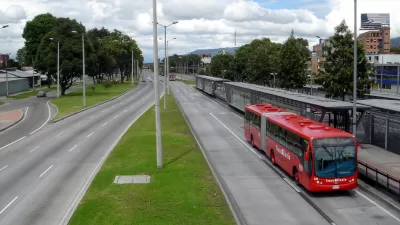It may not be sexy and it may not be fast, but the time has come to acknowledge the key role that the much maligned form of public transit will have in solving cities’ mobility woes, writes Will Doig.
Less expensive and easier to implement than rail-based mass transit, Doig looks to bus rapid transit as a system with the potential to revolutionize mobility in U.S. cities, as it has across the world, from Bogotá to Guangzhou.
According to Doig, "[m]aking people like the bus when not liking the bus is practically an American pastime essentially means making the bus act and feel more like a train. Trains show up roughly when they're supposed to. Buses take forever, then arrive two at a time. Trains boast better design, speed, shelters, schedules and easier-to-follow routes. When people say they don't like the bus but they do like the train, what they really mean is they like those perks the train offers. But there's no reason bus systems can't simply incorporate most of them."
Doig, with the assistance of transit consultant Jarrett Walker, offers some relatively easy fixes to vastly improve the image and functionality of bus systems anywhere, including increasing frequency, improving bus maps, enhancing predictability, upgrading bus stops, and raising the aesthetics of the buses themselves.
FULL STORY: It’s time to love the bus

Planetizen Federal Action Tracker
A weekly monitor of how Trump’s orders and actions are impacting planners and planning in America.

Restaurant Patios Were a Pandemic Win — Why Were They so Hard to Keep?
Social distancing requirements and changes in travel patterns prompted cities to pilot new uses for street and sidewalk space. Then it got complicated.

Maui's Vacation Rental Debate Turns Ugly
Verbal attacks, misinformation campaigns and fistfights plague a high-stakes debate to convert thousands of vacation rentals into long-term housing.

In California Battle of Housing vs. Environment, Housing Just Won
A new state law significantly limits the power of CEQA, an environmental review law that served as a powerful tool for blocking new development.

Boulder Eliminates Parking Minimums Citywide
Officials estimate the cost of building a single underground parking space at up to $100,000.

Orange County, Florida Adopts Largest US “Sprawl Repair” Code
The ‘Orange Code’ seeks to rectify decades of sprawl-inducing, car-oriented development.
Urban Design for Planners 1: Software Tools
This six-course series explores essential urban design concepts using open source software and equips planners with the tools they need to participate fully in the urban design process.
Planning for Universal Design
Learn the tools for implementing Universal Design in planning regulations.
Heyer Gruel & Associates PA
JM Goldson LLC
Custer County Colorado
City of Camden Redevelopment Agency
City of Astoria
Transportation Research & Education Center (TREC) at Portland State University
Jefferson Parish Government
Camden Redevelopment Agency
City of Claremont





























